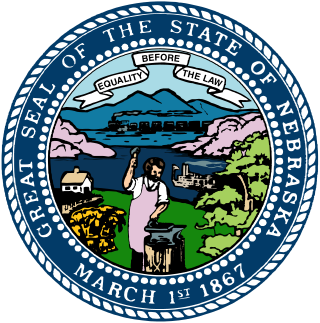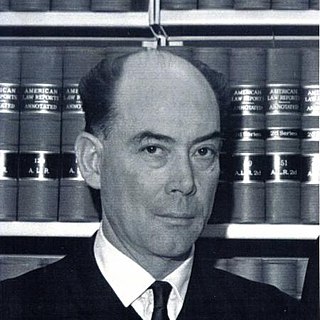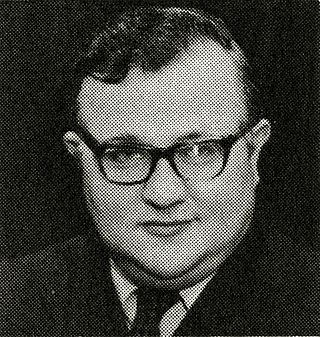Related Research Articles

The Supreme Court of Pennsylvania is the highest court in the Commonwealth of Pennsylvania's Unified Judicial System. It also claims to be the oldest appellate court in the United States, a claim that is disputed by the Massachusetts Supreme Judicial Court. The Supreme Court of Pennsylvania began in 1684 as the Provincial Court, and casual references to it as the "Supreme Court" of Pennsylvania were made official in 1722 upon its reorganization as an entity separate from the control of the royal governor.

The Tennessee Supreme Court is the highest court in the state of Tennessee. The Supreme Court's three buildings are seated in Nashville, Knoxville, and Jackson, Tennessee. The Court is composed of five members: a chief justice, and four justices. As of September 1, 2023, the chief justice is Holly M. Kirby.

The Supreme Court of Florida is the highest court in the U.S. state of Florida. It consists of seven justices—one of whom serves as Chief Justice. Six members are chosen from six districts around the state to foster geographic diversity, and one is selected at large.
The Alaska Supreme Court is the state supreme court for the U.S. state of Alaska. Its decisions are binding on all other Alaska state courts, and the only court its decisions may be appealed to is the Supreme Court of the United States. The Alaska Supreme Court hears appeals from lower state courts and also administers the state's judicial system.
The Alaska Court System is the unified, centrally administered, and totally state-funded judicial system for the state of Alaska. The Alaska District Courts are the primary misdemeanor trial courts, the Alaska Superior Courts are the primary felony trial courts, and the Alaska Supreme Court and the Alaska Court of Appeals are the primary appellate courts. The chief justice of the Alaska Supreme Court is the administrative head of the Alaska Court System.
The Alaska Court of Appeals is an intermediate court of appeals for criminal cases in the State of Alaska's judicial department, created in 1980 by the Alaska Legislature as an additional appellate court to lessen the burden on the Alaska Supreme Court. The court of appeals consists of a chief judge and three associate judges, who are all appointed by the governor of Alaska and face judicial retention elections every eight years; the chief judge of the court of appeals is selected from among the four by the chief justice of the supreme court to serve a two-year term.

The Indiana Supreme Court, established by Article 7 of the Indiana Constitution, is the highest judicial authority in the state of Indiana. Located in Indianapolis, the Court's chambers are in the north wing of the Indiana Statehouse.

The Supreme Court of Oklahoma is a court of appeal for non-criminal cases, one of the two highest judicial bodies in the U.S. state of Oklahoma, and leads the judiciary of Oklahoma, the judicial branch of the government of Oklahoma.

The Utah Supreme Court is the supreme court of the state of Utah, United States. It has final authority of interpretation of the Utah Constitution. The Utah Supreme Court is composed of five members: a chief justice, an associate chief justice, and three justices. All justices are appointed by the governor of Utah, with confirmation by the Utah Senate. The five justices elect one of their own to serve as chief justice and another to serve as associate chief justice, each for a term of four years.

The Wyoming Supreme Court is the highest court in the U.S. state of Wyoming. The Court consists of a Chief Justice and four Associate Justices. Each Justice is appointed by the Governor of Wyoming from a list of three nominees submitted by the judicial nominating commission, for an eight-year term. One year after being appointed, a new justice stands for retention in office on a statewide ballot at the next general election. If a majority votes for retention, the justice serves the remainder of the term and may stand for retention for succeeding eight-year terms by means of a nonpartisan retention ballot every eight years. A justice must be a lawyer with at least nine years' experience in the law, at least 30 years old, and a United States citizen who has resided in Wyoming for at least three years. Justices must retire when they reach 70 years of age.

The Colorado Supreme Court is the highest court in the U.S. state of Colorado. Located in Denver, the court was established in 1876. It consists of a Chief Justice and six Associate Justices who are appointed by the Governor of Colorado from a list of candidates approved by a state judicial commission. Each justice faces a retention election two years after his or her appointment and every ten years thereafter, with mandatory retirement at age 72.

The Nebraska Supreme Court is the highest court in the U.S. state of Nebraska. The court consists of a chief justice and six associate justices. Each justice is initially appointed by the governor of Nebraska; using the Missouri Plan, each justice is then subject to a retention vote for additional six-year terms. The six associate justices each represent a Supreme Court district; the chief justice is appointed at-large.
Lloyd A. Karmeier is a former American judge who served as a justice of the Illinois Supreme Court from the 5th district. He served as chief justice of that court from 2016 to 2019. Karmeier retired at the conclusion of his second term in December 2020.

The New Mexico Supreme Court is the highest court in the U.S. state of New Mexico. It is established and its powers defined by Article VI of the New Mexico Constitution. It is primarily an appellate court which reviews civil and criminal decisions of New Mexico's trial courts of general jurisdiction and certain specialized legislative courts, only having original jurisdiction in a limited number of actions. It currently resides in the New Mexico Supreme Court Building in Santa Fe.

The Oklahoma Court of Criminal Appeals is one of the two highest judicial bodies in the U.S. state of Oklahoma and is part of the Oklahoma Court System, the judicial branch of the Oklahoma state government.
In the United States, the government of each of the 50 states is structured in accordance with its individual constitution. In turn, each state constitution must be grounded in republican principles. Article IV, Section 4, Clause 1 of the United States Constitution tasks the federal government with assuring that each state's government is so organized.

Buell Arthur Nesbett was an American soldier, lawyer, businessman, and the first chief justice of the Alaska Supreme Court.

George Frank Boney was a justice of the Supreme Court of Alaska from December 2, 1968, until his death, serving as chief justice after 1970.
Harry Oscar Arend was an American jurist who served as a justice of the Alaska Supreme Court from May 1960 to January 1965. He is the only member of this court to have lost an election for retention to office. A street is named in his honor in the outskirts of Ester, Alaska.
John Henry Dimond was an American jurist who served as a justice of the Supreme Court of Alaska from August 7, 1959 to November 30, 1971. He was one of Alaska's inaugural justices, serving along with Buell Nesbett and Walter Hodge on the court's first ever bench. Born in Valdez, Alaska, he was the only son of Anthony Dimond, and was briefly in private practice with his father prior to his death. The state courthouse in his adopted hometown of Juneau, Alaska, located across the street from the Alaska State Capitol, is named in his honor.
References
- ↑ Was raised in Juneau and resided there until just months before his appointment to the court.
- ↑ Was born and raised in Seward.
- ↑ "Primary, General, and Statewide Special Election Results". Alaska Division of Elections.